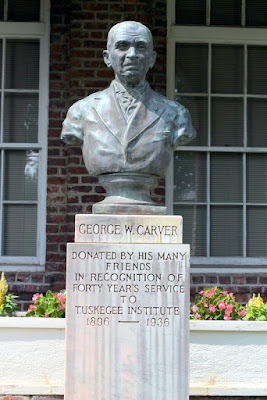There are two park service sites in the little town of Tuskegee that are not to be missed, Tuskegee Institute National Historic Site and at Moton Field the Tuskegee Airmen National Historic Site. The institute was started in 1881 as the Tuskegee Normal School for Colored Teachers. The first leader of the school, Booker T. Washington, started the school with 30 students who met in a small shanty on the grounds of a church.
A big part of the students lives was working to raise their own food. They also constructed many of the original buildings that were designed by Tuskegee architect Robert R. Taylor who was the first African American graduate of Massachusetts Institute of Technology. They even made the bricks for the buildings on campus. This is Tompkins hall that was the dining and assembly hall. It still serves that purpose as well as being the student union.
The George Washington Carver Museum has many displays of his work on innovative farming methods for the Southern farmers, While he is remembered for his work with peanuts he worked on all areas of agriculture.
The exact date of Carver's birth is not known, but he was born into slavery during the Civil War in Missouri. In 1890 he entered Simpson College to study art and piano. A teacher recognized his talents and urged him to enter Iowa State, where he was the first Black student, to study botany. After graduating he became the first Black faculty member at Iowa State. In 1896 Booker T. Washington hired him to teach at Tuskegee where he stayed for over 40 years.
Some of the artifacts from Carver's lab.
Tuskegee had a mobile school that would travel around the rural areas of the south to teach the farmers the latest farming methods that Carver and others were working on at the institute. The Jessup Wagon was named for Morris K. Jessup, who financed the project.
The Oaks, Booker T. Washington's private home, was also designed by Robert Taylor. It was the most modern home in the county at that time. Washington wanted it to be an example of what could be achieved when someone became educated.
The graves of Carver, who died in 1943, and Washington, who died in 1915. Between the two of them they spent over 80 years at Tuskegee Institute.
One of the areas of study at Tuskegee was aeronautics. In the late 1930's with the war in Europe the government started the Civilian Pilot Training Program. After Roosevelt visited Tuskegee in 1939 the institute began to receive money to train African American pilots. Above is Moton Field, the only remaining training site.
In 1941 the all Black 99th Pursuit Squadron started training. The first class graduated in 1942 and graduate pilots were commissioned 2nd Lieutenants in the Army Air Corps. Among the first graduates was Benjamin O. Davis who was already an Army captain and West Point graduate. Davis was made a Lieutenant Colonel and given command of the 99th. He served over 40 years and became the first Black general. The Stearman PT-17 was used for flight training.
In addition to training 994 pilots, Tuskegee also trained about 17,000 support personnel including mechanics, communication and electrical specialists, armaments specialists, parachute riggers, cooks and others. Many of these jobs were done by women and all those who were there were considered Tuskegee Airmen.
Of course, even though they were fighting and dying for their country, the Tuskegee Airmen still faced discrimination at home and on base. They took up the idea of the Double V: victory at home and aboard. Even though the segregation signs came down at Tuskegee, pilots in the 447th Bombardment Group at ironically named Freeman Field in Indiana were arrested for peacefully protesting a segregated officers club. Finally in 1948, President Truman issued Executive Order 9981 calling for the end of segregation in the U.S. military.
In 1944 the 99th along with the 332nd began flying the P-51, the best fighter the U.S. had during WWII. They became known as the Red Tails when the painted the tails of the P-51 red. They escorted bombers flying over Germany to bomb oil refineries. During the war the Tuskegee Airmen flew 1,578 missions and shot down 112 enemy planes. 66 airmen were killed, 32 were taken as POWs and 13 were MIA.
These two pictures, now on display in the hanger here, are from the Tuskegee Airmen float we saw at the 2010 Rose Parade. We actually saw these being made when we toured the float building company.
We even got to meet some of the airmen. Here is Nanc shaking hands with one of the original Tuskegee Airmen, very neat.
This is the float with the Red Tails carrying several of the airmen. The picture on the left is one of the ones we saw in Tuskegee. If you are near Tuskegee, Alabama a visit to the institute and Moton Field should be on your to do list.


















1 comment:
I just visited the US Air Force Museum in Dayton and read a lot about the Tuskegee Airmen there. Glad they are finally getting the recognition they should have received then.
Post a Comment